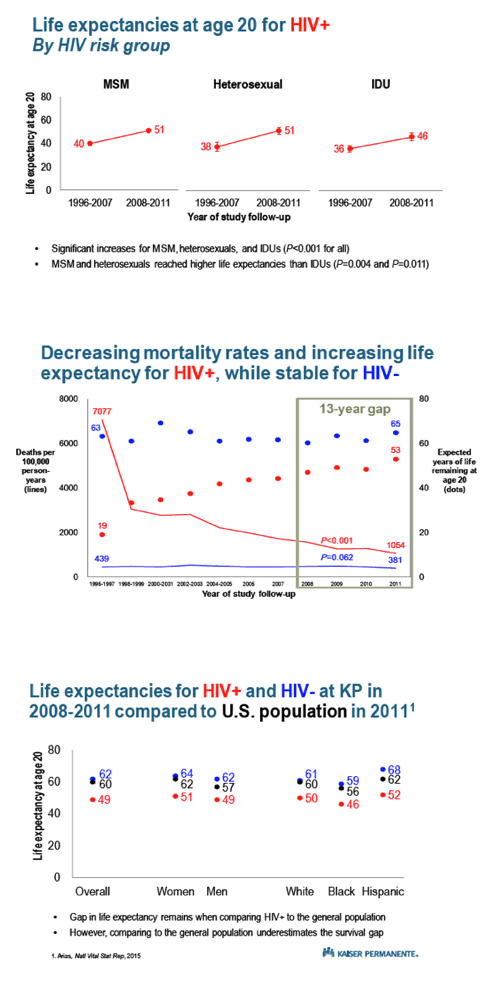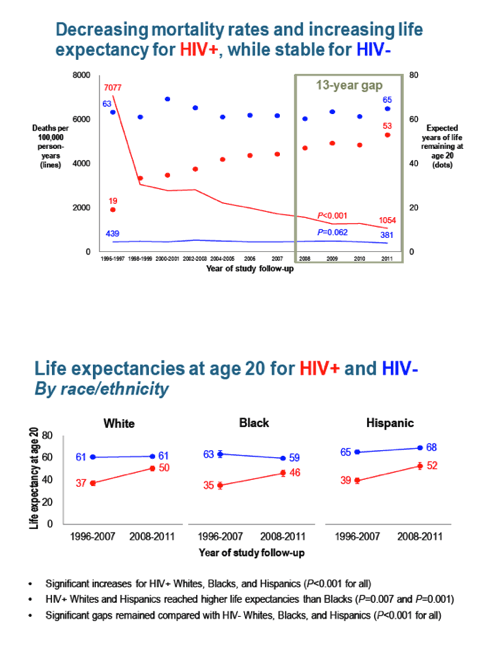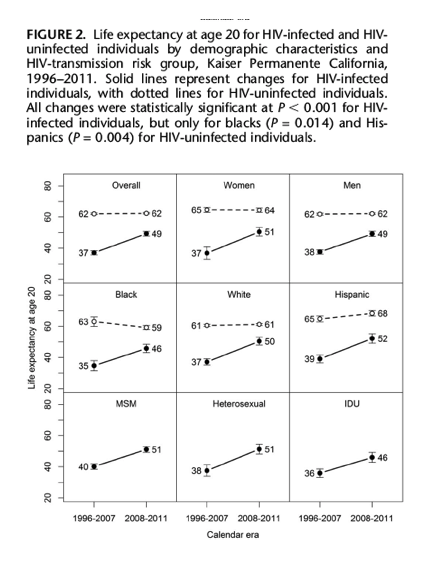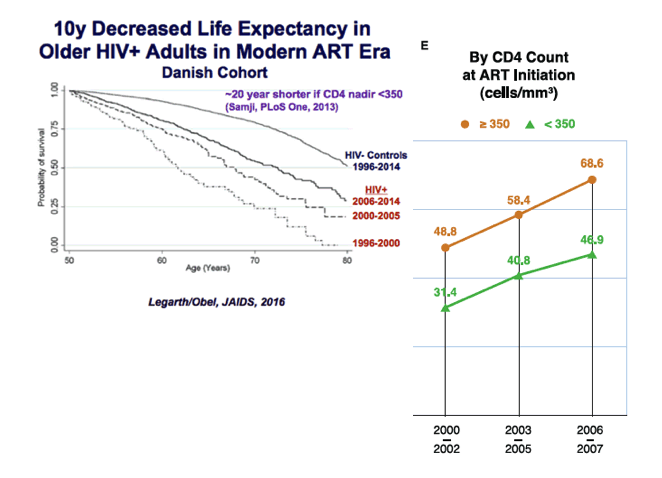| |
2008-2011 / HIV 13 Year Gap Life Expectancy Projected HIV+ vs
HIV-Neg: 11 years for Whites; 13 yrs for Blacks; Hispanic 16 yrs.
|
| |
| |
"Narrowing the Gap in Life Expectancy Between HIV-Infected and HIV-Uninfected Individuals With Access to Care"
from Jules: earlier I sent you a report from earlier days conducted from 2000-2007 in HIV where life expectancy was predicted and stratified by CD4 count & for those with baseline CD4 <350 predicted life expectancy was 20 years less than the general population and for those with >350 CD4 life expectancy was 10 years less than the general population. Some may think well in those earlier days patients had a history of taking ARTs associated with more toxicities while life expectancy would improve a lot after everyone was taking better & less toxic ARTs. NOT THE CASE...in this study below they looked at the yeas of 2008 to 2011. This study I report below which was published in 2016 from Kaiser Permanente & reported at CROI 2016, they did NOT look at life expectancy by CD4 but looked at gender, ethnicity, and how one was infected; in this study there was a 10-13 year gap and since they did not look at differences based on CD4 it is likely life expectancy will be less than the 10-13 years gap, would it have been 20 years like the earlier study? We do not know, but it certainly would be a bigger gap than 10-13 years!
Pdf attached
Download the PDF here
Narrowing the gap in life expectancy for HIV+ compared with HIV- individuals...Life Expectancy Gap Between HIV+ and HIV- Narrows But Persists - Mark Mascolini - (02/25/16)
http://www.natap.org/2016/CROI/croi_25.htm



-------------------------
Life Expectancy in HIV ....when CD4 <350 its reduced, with comorbidities ???? what do you think?
from Jules: studies examining life expectancy in HIV can only project estimates, it is not possible to predict the "real" impact of comorbidities on life expectancy. We will only know years from now what the "real" survival rates are for today's 1st aging older generation, and only then can we know the impact of comorbidities, because its impossible to predict how many & what types of comorbidities an individual will have, and its impossible to predict how they will affect each person, as each person's experience will be different. Many HIV+ are not tested for comorbidities nor do they receive timely and good care & treatment & prevention regarding the comorbidities. The response to comorbidities will vary by individual because of genetics, lifestyle practices like exercising & diet, and there are many variables. Here are 2 representative studies worth noting. The 1st study is from earlier years and found HIV+ with lower CD4, <350, had 20 years less survival. the 2nd study below looked at HIV+ over 50 without comorbidities and found 25 year survival for HIV+ compared with 34 years from the general population control group they used and found a 1.6 increased risk of death among this group of HIV+. I am convinced over the next years we will find significantly increased death rates and the number & severity of comorbidities including in particular frailty will have a big impact on survival. Then there is the matter of quality of life. Is there any doubt quality of life will be significantly lower in HIV+ with multi-comorbidity particularly with cognitive impairment, kidney disease, cancers, frailty, fractures. We need support programs carved out of Ryan White Care Act funding to address the needs of these patients and their clinics. HHS & HRSA & CDC, and the National Strategy on HIV & AIDS, and advocates must be responsive to these needs. The National Stratgey on HIV & AIDS does not address this problem & must be changed to include language on this.
http://journals.plos.org/plosone/article?id=10.1371/journal.pone.0081355
We aim to estimate temporal changes in life expectancy among HIV-positive adults on ART from 2000-2007 in the U.S. and Canada. Participants were from the North American AIDS Cohort Collaboration on Research and Design (NA-ACCORD), aged ≥20 years and on ART. Mortality rates were calculated using participants' person-time from January 1, 2000 or ART initiation until death, loss to follow-up, or administrative censoring December 31, 2007. Life expectancy at age 20, defined as the average number of additional years that a person of a specific age will live, provided the current age-specific mortality rates remain constant, was estimated using abridged life tables. Life expectancy increased from 36.1 [standard error (SE) 0.5] to 51.4 [SE 0.5] years from 2000-2002 to 2006-2007. Men and women had comparable life expectancies in all periods except the last (2006-2007). Life expectancy was lower for individuals with a history of injection drug use, non-whites, and in patients with baseline CD4 counts <350 cells/mm, [20 years shorter vs with baseline CD4>350, see graph below]
A 20-year-old HIV-positive adult on ART in the U.S. or Canada is expected to live into their early 70 s, a life expectancy approaching that of the general population. Differences by sex, race, HIV transmission risk group, and CD4 count remain.
Download the PDF here
Pdf attached above
-----------------------
Long-Term Mortality in HIV-Infected Individuals 50 Years or Older: A Nationwide, Population-Based Cohort Study - (02/08/16)
Among HIV-infected individuals without comorbidity the estimated median survival time from age 50 years was 25.6 years (to age 75.6 years) (95% CI: 23.8 to NA) compared with 34.2 years (age 84.2 years) (95% CI: 29.6 to 38.3) among population controls without comorbidity. MRR was 1.7 (95% CI: 1.2 to 2.3) for HIV-infected individuals compared with population controls.........In our study we included a well-treated subpopulation of HIV-infected individuals ≥ 50 years with undetectable HIV RNA and CD4 cell count ≥ 350 cells per microliter after 1 year of cART. We detected a 1.6-fold increased risk of death of among HIV-infected individuals ≥ 50 years without comorbidity compared with population controls without comorbidity, which is in line with the findings of Lohse et al who found a 1.7-fold increased mortality in HIV-infected individuals with CCI = 0 compared with population controls with CCI = 0.
----------------------
Aging & Inflammation: 10 yrs decreased life expectancy/T-cell activation remind high despite viral suppression/inflammation markers predict disease & death- "Pathophysiology of Non-Communicable Diseases in Treated HIV Infection: Is there a common path?" talk by Peter Hunt - (07/22/16)
http://www.natap.org/2016/IAC/IAC_39.htm

|
|
| |
| |
|
|
|